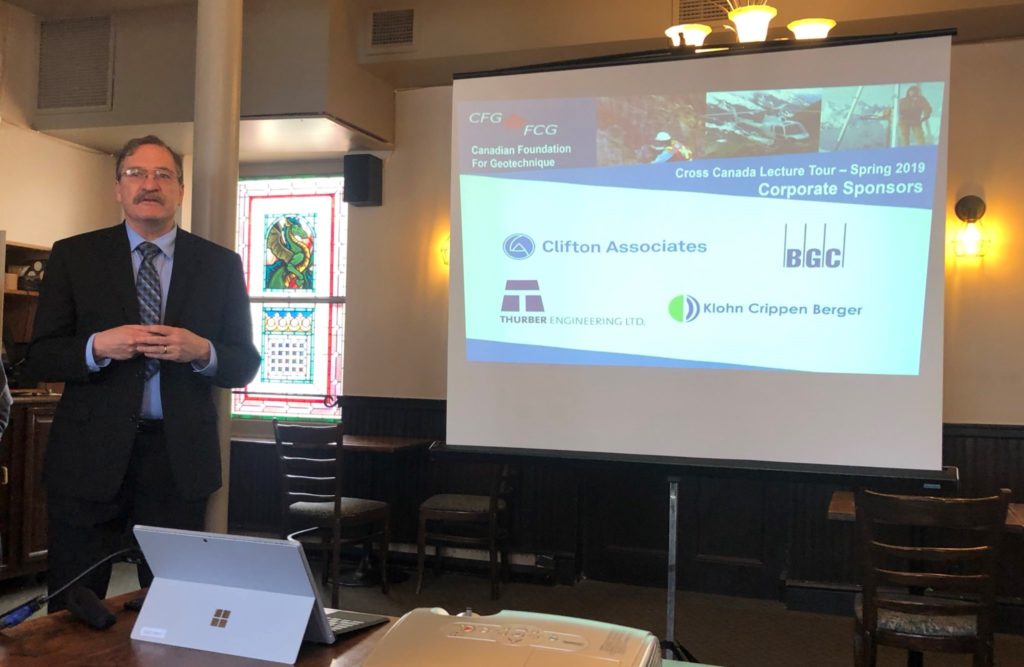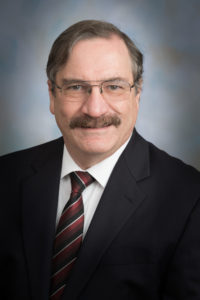
Ask Civil Engineering Chair Chuck Shackelford what he did over summer break – betcha he’s got you beat.
He gave 12 lectures in eight Canadian provinces, traveling 4,000 miles in three weeks.
He’s also first – as in the first Colorado State University civil engineering professor invited to speak in the Cross Canada Lecture Tour (CCLT). Each year for 53 years, the Canadian Geotechnical Society has invited one prominent Canadian geotechnical professional and one international professional to present.
Shackelford shared his research and expertise with about 200 civil and environmental engineering professionals, academics and graduate students. His research relates to understanding and preventing the movement of hazardous chemicals or contaminants through clay and polymer membranes commonly used as engineered barriers to contaminant migration in waste containment applications such as landfills and lagoons.
Within a continuous three-week period in May and June, Shackelford visited cities in Newfoundland and Labrador (St. John’s), New Brunswick (Fredericton), Quebec (Montreal and Quebec City), Ontario (Kingston, Ottawa, Thunder Bay), Manitoba (Winnipeg), Alberta (Calgary and Edmonton), Saskatchewan (Regina) and British Columbia (Vancouver). His travel was funded by the Canadian Foundation for Geotechnique.
Engineering Source talked with Shackelford about his trip:
Q: Was this your first time in Canada? Are you Canadian?
A: I’ve been to Canada about a half dozen times for conferences, invited seminars, and as an outside member of two Ph.D. committees. I am not Canadian (but I do play hockey!).

Q: Wait. What? You play hockey?
A: I started to learn to ice skate at the ripe young age of 54 about 11 years ago (early 2009) with the goal of playing hockey in the Fort Collins Adult Hockey Association beginning September of that year. I just finished my 10th season of hockey. I also play in an over 40 pickup league on Saturdays at the NOCO Ice Center in Windsor. I’m the oldest player (64) in this group.
Q: So back to your trip – how were you selected?
A: My understanding is that there is a committee of the Canadian Geotechnical Society that picks the recipients based on their international reputation in the field. I did not apply for the award, but simply was contacted about a year ago and informed that I had been selected. I’m the 103rd recipient of the Cross Canada Lecture Tour, which has been going on since 1965. Recipients have come from all over the world in addition to Canada and the U.S.
Q: You discussed three topics on your tour. What were they?
A: Diffusion of chemicals through compacted clay barriers used for waste containment was the topic of my Ph.D. dissertation in 1988, and I have been working in this area ever since (30-plus years). This area of research is probably the area for which I am best known, and also was the topic of my Kerry Rowe Lecture awarded to me by the International Society of Soil Mechanics and Geotechnical Engineering in 2013. The person for whom the lecture is named, Kerry Rowe, is an internationally recognized scholar in Environmental Geotechnics at Queens University in Kingston, Ontario, Canada. As a result, the individual selected for the Rowe Lecture publishes a subsequent paper in the Canadian Geotechnical Journal.
The topic of membrane behavior and chemico-osmosis in clays is an original line of research I started here at CSU back around 1996, and my research group has produced an extensive number of publications on this topic over the past 20-plus years. The research on this topic has been funded almost exclusively by five sequential NSF research grants over the same period, and the research has stimulated other research efforts on the same topic at the Politecnico di Torino in Italy, Ghent University in Belgium, and Kyoto University in Japan.
“The topic of membrane behavior and chemico-osmosis in clays is an original line of research I started here at CSU back around 1996, and my research group has produced an extensive number of publications on this topic over the past 20-plus years.”

The research on enhanced bentonites for sustainable chemical containment has been ongoing for about 10 or so years and still is an active area of research in our field. This research focuses on chemically treated sodium bentonite — a naturally occurring, high swelling clay – to improve the engineering properties of chemical containment barriers comprising bentonites. This was the topic of my colleague’s (Joe Scalia) Ph.D. dissertation at the University of Wisconsin-Madison (UWM), and our work here in this topic resulted from a joint research project between Colorado State University and UWM funded by NSF. Joe was prof. Craig Benson’s Ph.D. student at UWM, and Gretchen Bohnhoff was my Ph.D. student on this project here at CSU. A paper we published on this topic was just selected this past semester as the best paper published last year in Geosynthetics International, and there will be an awards ceremony in London in October that I plan to attend to receive the award.
Q: What did you bring back from your trip?
A: That Canada is a fantastic country and that Canadians are among the friendliest people in the world. I was treated like royalty during this CCLT.
Q: Did you have time for fun? What was the coolest thing you did or saw?
A: The travel schedule was extremely hectic. I did go out to several dinners with the local section directors and members, which were fun. In St. John’s, which I didn’t know existed until this activity, I did get a tour of the area. In Calgary, I had lunch at the Calgary Tower. Great fun. Experience of a lifetime.